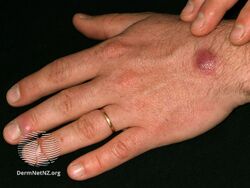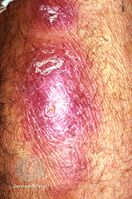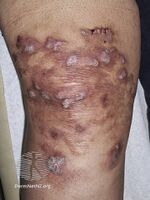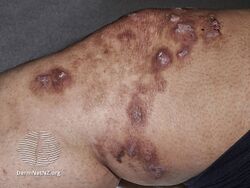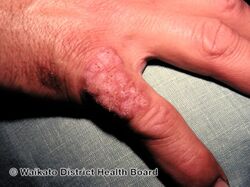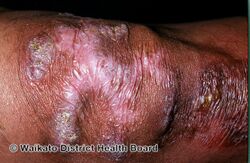Mycobacterium marinum
| Mycobacterium marinum | |
|---|---|
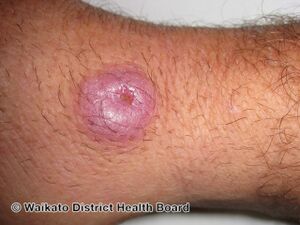 | |
| Specialty | Infectious disease |
| Symptoms | Reddish painless bumps usually on an arm or hand[1] |
| Causes | Mycobacterium marinum |
| Risk factors | Fish tank[1] |
| Treatment | Antibiotics[1] |
| Medication | Clarithromycin and ciprofloxacin for 8-12 weeks[1] |
| Mycobacterium marinum | |
|---|---|
| Scientific classification | |
| Domain: | |
| Phylum: | |
| Class: | Actinobacteria
|
| Order: | |
| Family: | |
| Genus: | |
| Species: | M. marinum
|
| Binomial name | |
| Mycobacterium marinum | |
Mycobacterium marinum, also known as fish tank granuloma, is a skin infection which presents as one or more reddish painless bumps usually on an arm or hand of typically someone who cleans out fish tanks.[1] It may spread along the lymphatic drainage.[2]
It is caused by a slow growing mycobacterium (SGM) belonging to the genus Mycobacterium and the phylum Actinobacteria.[3]
The strain marinum was first identified by Aronson in 1926 and it is observed as a pathogenic mycobacterium.[4] For example, tuberculosis like infections in fish (mycobacteriosis) and skin lesions in humans.[4] Whole genome sequence of M. marinum (M strain) was first published in 2008[5] and later with the emerge of Next Generation Sequencing (NGS), marinum type strain or patient isolates genome sequences were published.[6][7]
Phylogeny
Initial phylogenetic studies using the gene 16S rDNA sequence data shows M. marinum is close to the M. tuberculosis and M. ulcerans.[3]
Humans
Mycobacterium marinum is a mycobacterium which can infect humans. It was formerly known as Mycobacterium balnei.[8] Infection is usually associated either with swimming or with keeping or working with fish (aquarium granuloma).[8]
-
-
-
-
Mycobacterium marinum
-
Mycobacterium marinum
-
Mycobacterium marinum
-
-
References
- ↑ 1.0 1.1 1.2 1.3 1.4 Wakelin, Sarah H. (2020). "22. Dermatology". In Feather, Adam; Randall, David; Waterhouse, Mona (eds.). Kumar and Clark's Clinical Medicine (10th ed.). Elsevier. p. 671. ISBN 978-0-7020-7870-5. Archived from the original on 2021-12-11. Retrieved 2021-12-11.
- ↑ Akram, Sami M.; Aboobacker, Shamma (2022). "Mycobacterium Marinum". StatPearls. StatPearls Publishing. PMID 28722913. Archived from the original on 2021-10-22. Retrieved 2022-05-23.
- ↑ 3.0 3.1 Whitman W, Goodfellow M, Kämpfer P, Busse HJ, Trujillo M, Ludwig W, Suzuki K, Parte A, eds. (2012). Bergey's Manual of Systematic Bacteriology. Bergey's Manual of Systematic Bacteriology. Vol. 5: The Actinobacteria (2nd ed.). New York: Springer-Verlag. ISBN 978-0-387-95043-3. Archived from the original on 2021-05-27. Retrieved 2021-05-07.
- ↑ 4.0 4.1 Aronson JD (1926). "Spontaneous Tuberculosis in Salt Water Fish". The Journal of Infectious Diseases. 39 (4): 315–320. ISSN 0022-1899.
- ↑ Stinear TP, Seemann T, Harrison PF, Jenkin GA, Davies JK, Johnson PD, et al. (May 2008). "Insights from the complete genome sequence of Mycobacterium marinum on the evolution of Mycobacterium tuberculosis". Genome Research. 18 (5): 729–41. doi:10.1101/gr.075069.107. PMC 2336800. PMID 18403782.
- ↑ Yoshida M, Fukano H, Miyamoto Y, Shibayama K, Suzuki M, Hoshino Y (May 2018). "T, Obtained Using Nanopore and Illumina Sequencing Technologies". Genome Announcements. 6 (20). doi:10.1128/genomeA.00397-18. PMC 5958268. PMID 29773624.
- ↑ Das S, Pettersson BM, Behra PR, Mallick A, Cheramie M, Ramesh M, et al. (August 2018). "Extensive genomic diversity among Mycobacterium marinum strains revealed by whole genome sequencing". Scientific Reports. 8 (1): 12040. doi:10.1038/s41598-018-30152-y. PMID 30104693.
- ↑ 8.0 8.1 Bhatty MA, Turner DP, Chamberlain ST (March 2000). "Mycobacterium marinum hand infection: case reports and review of literature". British Journal of Plastic Surgery. 53 (2): 161–5. doi:10.1054/bjps.1999.3245. PMID 10878841.

